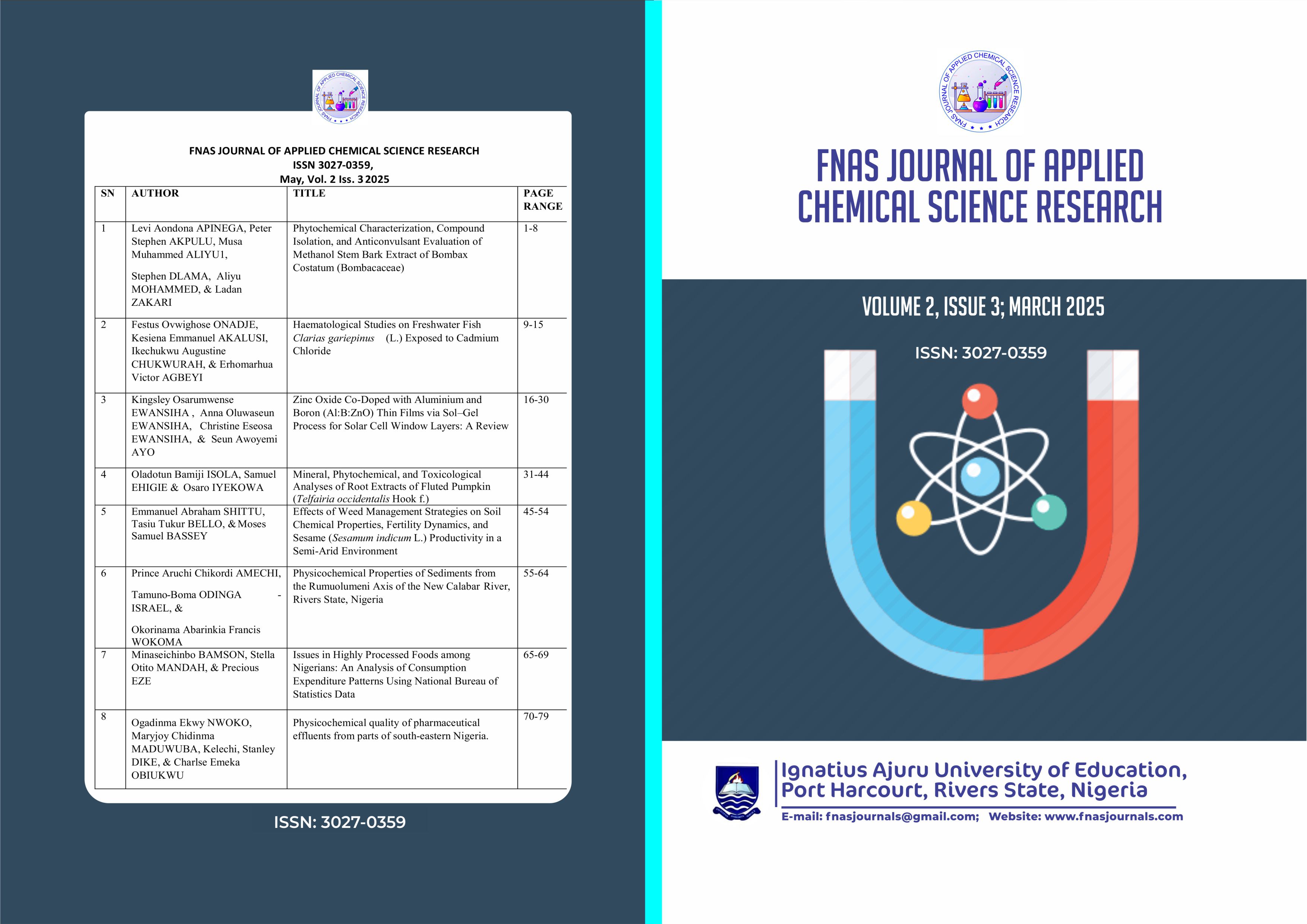Microbial Population Dynamics of Paracetamol and Ibuprofen Impacted Effluent
DOI:
https://doi.org/10.63561/jacsr.v2i3.978Keywords:
Pharmaceuticals, Effluents, Paracetamol, Ibuprofen, Population DynamicsAbstract
Pharmaceutical contaminants such as paracetamol and ibuprofen are emerging environmental pollutants of concern due to their persistence in aquatic environments and potential to disrupt microbial communities. This study examined the microbial population dynamics in four pharmaceutical effluents impacted by these drugs. The microbial populations enumerated were total culturable heterotrophic bacterial counts (TCHBC), total culturable fungal counts (TCFC), total culturable paracetamol utilizing bacterial counts (TCPUBC), total culturable Ibuprofen utilizing bacterial counts (TCIUBC), and total culturable paracetamol and ibuprofen utilizing bacterial counts (TCPIUBC). Results revealed that the TCHBC ranged from 7.9x106± 2.824 Cfu/ml – 2.1x108±1.333 Cfu/ml, TCFC ranged from 3.2x106±1.331 Cfu/ml -2.17x107±2.663 Cfu/ml, TCPUBC ranged from1.4x107±2.306 Cfu/ml -8.0x108±1.331 Cfu/ml, TCIUBC ranged from 2.25x106±1.331 Cfu/ml - 1.7x108±2.306 Cfu/ml while TCPIUBC ranged from 1.7x107± 1.331 Cfu/ml – 1.0x108±2.303 Cfu/ml. The elevated abundance of pharmaceutical-utilizing bacteria suggests adaptive responses within the microbial community, enabling the metabolism of paracetamol and ibuprofen as carbon sources. Such adaptation highlights the potential role of indigenous microbial populations in the natural attenuation of pharmaceutical contaminants. These findings underscore the ecological significance of microbial community dynamics in contaminated effluents and support the development of enriched bacterial consortia for targeted bioremediation in pharmaceutical wastewater treatment systems.
References
Al Aukidy, M., Verlicchi, P., Jelic, A., Petrovic, M., & Barceló, D. (2012). Monitoring release of pharmaceutical compounds: Occurrence and environmental risk assessment of two WWTP effluents and their receiving bodies in the Po Valley, Italy. Science of the Total Environment, 438, 15–25. https://doi.org/10.1016/j.scitotenv.2012.08.061 DOI: https://doi.org/10.1016/j.scitotenv.2012.08.061
APHA (2005) Standard Methods for the Examination of Water and Wastewater. 21st Edition, American Public Health Association/American Water Works Association/Water Environment Federation, Washington DC.
APHA (2015) Standard Methods for the Examination of Water & Wastewater. 21st Edition, American Public Health Association.
Verlicchi, P., & Zambello, E. (2015). Pharmaceuticals and personal care products in untreated and treated sewage sludge: Occurrence and environmental risk in the case of application on soil—A critical review. Science of the Total Environment, 538, 750–767. https://doi.org/10.1016/j.scitotenv.2015.08.108 DOI: https://doi.org/10.1016/j.scitotenv.2015.08.108
Żur, J., Piński, A., Marchlewicz, A., Hupert-Kocurek, K., Nowak, A., & Wojcieszyńska, D. (2018a). Organic micropollutants paracetamol and ibuprofen—Toxicity, biodegradation, and genetic background of their utilization by bacteria. Environmental Science and Pollution Research, 25(3), 21498–21524. https://doi.org/10.1007/s11356-018-2435-2 DOI: https://doi.org/10.1007/s11356-018-2517-x
Żur, J., Wojcieszyńska, D., & Guzik, U. (2018b). Metabolic versatility of microbial degraders of paracetamol. Critical Reviews in Biotechnology, 38(6), 791–804. https://doi.org/10.1080/07388551.2017.1413981
Żur, J., Wojcieszyńska, D., & Guzik, U. (2023). Biodegradation of pharmaceuticals by bacterial consortia: Current knowledge and future perspectives. Molecules, 28(5), 2185. DOI: https://doi.org/10.3390/molecules28052185


